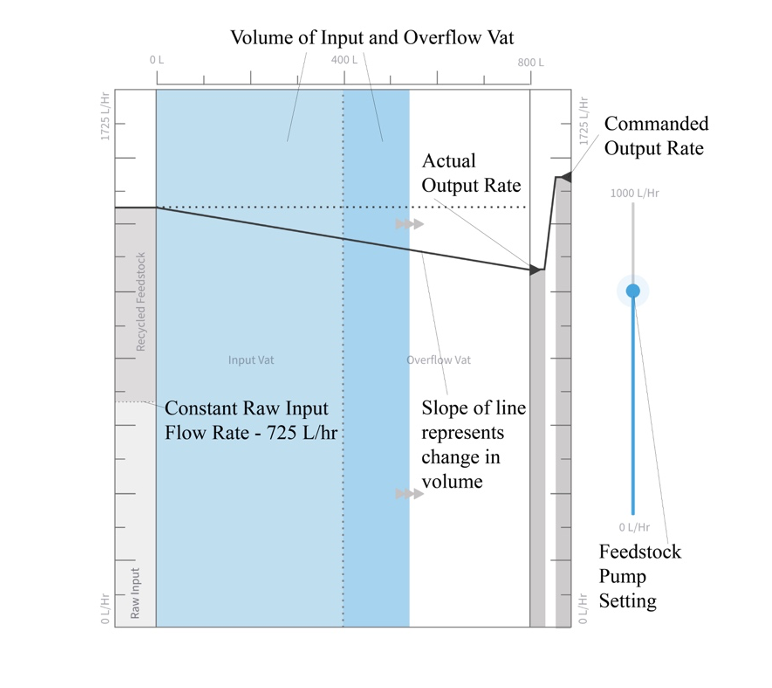Thermal Plant User Interface
Project
This work was done as a part of an Ecological Interface Design Class by a team of four members (including me) who were all graduate students.
The brief was to conduct research and design an ecological interface for the supervisory control of a thermal plant designed to heat a given liquid.
We were assessed on our ability to effectively research and map work domain relationships onto an interface based on a written and pictorial description of the thermal plant.
Physical description of the system. The locations of the various sensors are labeled T, V, and R.
'T' - Temperature sensors
'V' - Volume sensors
'R' - Flow Rate Sensors
'S' - Temperature and flow rate control points
Overview
We asked the following questions to help guide our design:
What are the operator's chief goals?
What are the important relationships that the operator must know to achieve their goals?
What are the best ways to depict the relationships to the operator?
What controls can the operator manipulate to achieve these goals?
Work
My primary role in the team was to research the work domain relationships and make design decisions about their depiction on the interface. I divided my work into three phases - Research, Ideation, and Design.
Research
What are the operator's chief goals?
I read the description of the thermal plant and identified its core functions. The operator's chief goals were to:
heat the liquid to a specified temperature range
keep the liquid flowing through the system at a minimum flow rate to avoid overflowing the liquid reservoirs
What are the important relationships that the operator must know to achieve their goals?
After conducting an in-depth analysis of the physical laws governing the thermal plant, I identified three key relationships between variables.
A higher input flow rate will increase the volume in a reservoir. Conversely, a greater output flow rate will decrease it. The two flow rates have to be equal to maintain a constant volume.
The liquid's temperature in a given container (vat) will jointly depend on the volume and temperature of the liquid from different sources.
The flow rate and heater's temperature will determine the heat exchange between the heater and the passing liquid.
What are the best ways to depict the relationships to the operator?
I conducted a cognitive task analysis to understand how the user would interact with the system. This included identifying task priority levels.
I then studied which relationships and system elements corresponded to each task and organized them in the form of an abstraction hierarchy, breaking the system's complexity down into manageable levels.
What controls can the operator manipulate to achieve these goals?
I identified control points for flow rates and temperature settings. Based on my physical analysis, I identified two ways in which the operator could achieve system goals.
To increase the temperature of the liquid,
the operator could decrease the flow rate of the liquid at the heat exchanger to increase the duration for which the liquid is in contact with the heater,
or they could increase the temperature of the heater while keeping the flow rate constant.
Taking these relationships into account, I mapped all the physical processes taking place at various points in the plant as given below:
Ideation
Based on the abstraction hierarchy, it became clear which relationships and information were the most important. I collaborated with the designers in my team to brainstorm ideas based on four key goals:
No hidden information: The operator should be able to access all types of information.
Direct Perception: The user should be able to use the interface as a medium that maps the constraints of the work domain and supports the affordances or boundaries for actions. They should not need to expend cognitive resources to interpret what an interface depiction means for the actual thermal plant.
Direct Manipulation: The interface should allow the user to control the interface directly through skill-based actions and provide continuous feedback on the consequences of their actions.
Visual Momentum: The user should not have to expend cognitive resources into integrating information from various displays. Functional relationships between variables should be highlighted and transitions between views should be smooth.
Based on my research on the effective depiction of similar physical relationships in other interfaces, I led my team through the ideation phase, where we sketched out rough interface ideas.
Design
I collaborated with my team members to design the interface in Adobe XD. We created and connected the individual frames for various displays and views.
Interface Overview
Direct Perception
Direct Manipulation
Visual Momentum
Outcomes and Reflection
At the end of the project, our professor revealed the actual interface implemented in the thermal plant, and our interface closely matched its functional properties.
Our interface was voted the best in the class, and we got an A for the project.
Throughout this project, I learned:
How to work collaboratively with a team to achieve optimal results
How to execute and deliver a project from the research stage to the design state
The basics of Adobe XD











